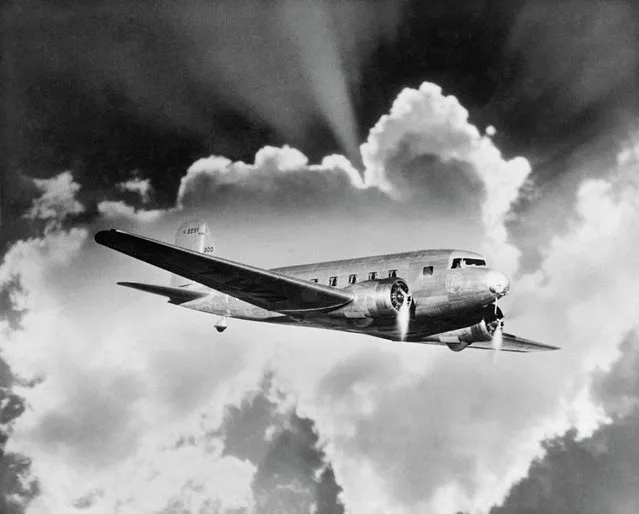
Douglas DC-3 airliner. Advertising image prepared by Aerofilms for a client showing rays of sunshine from behind a cloud.The DC-3 entered civilian service with American Airlines in 1936. (Photo by Aerofilms Collection via “A History of Britain From Above”)
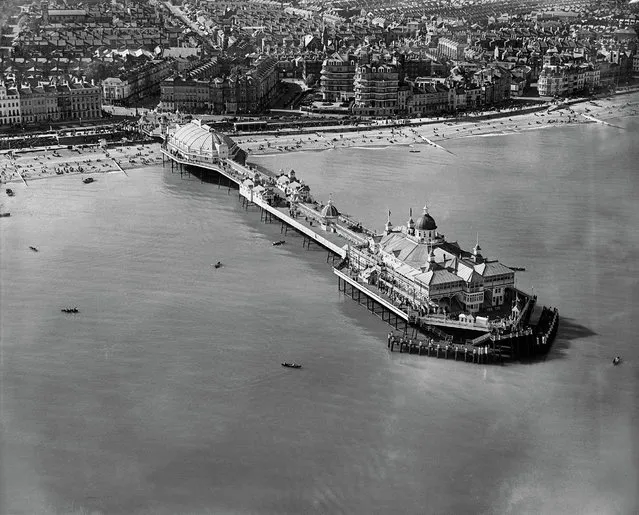
While the lido was described as bringing “modernism to the masses” on the British coast it was just the latest example of a trend that had been developing since Victorian times – transforming seaside towns into resorts for leisure and entertainment. In the latter half of the nineteenth century, the fashion was for local authorities to build great piers stretching from the promenade out into the sea. The Eastbourne Pier, pictured here in May 1931, was erected between 1866 and 1870 to an ingenious design by Eugenius Birch, which saw the structure sitting on special cups allowing the supporting struts to “move” in bad weather. Arranged on the pier's 1,000-foot length were kiosks, a theatre, a ballroom and a camera obscura. 1931. (Photo by Aerofilms Collection via “A History of Britain From Above”)
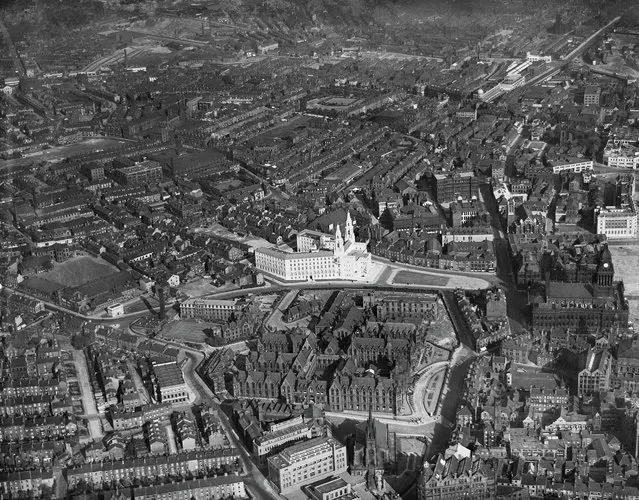
Leeds showing new Town Hall – September 1933. (Photo by Aerofilms Collection via “A History of Britain From Above”)
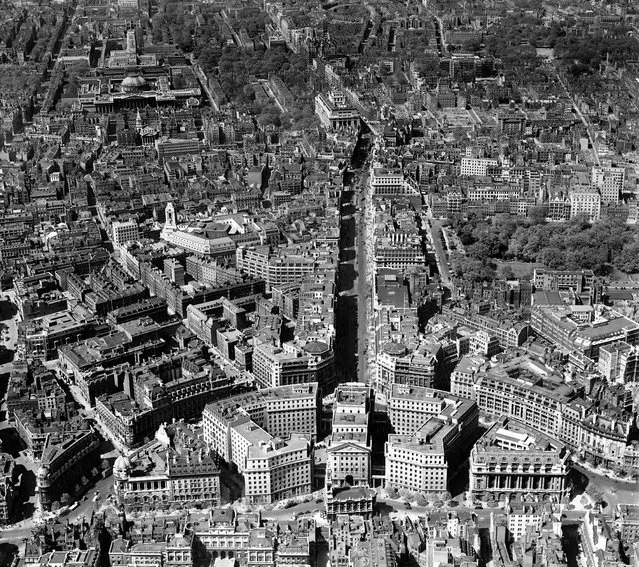
Bush House, Kingsway and the British Museum, Westminster, 1946 With the grand façade of the British Museum just visible in the top left, the central London transport artery of the Kingsway is picked out here in strong shadow running down to the monolithic Bush House office complex. When first opened in July 1925 at a construction cost of £2 million. Bush House was declared the most expensive building in the world. Originally built for an Anglo- American trading organisation headed by a man called Irving T Bush, its huge size soon saw other firms leasing office space including Aerofilms. In 1932, Francis Wills oversaw the rental of 1,000 square feet of the basement of Bush House to accommodate the company drawing offices, darkrooms, and, most important of all, the vast photo library. 1946. (Photo by Aerofilms Collection via “A History of Britain From Above”)
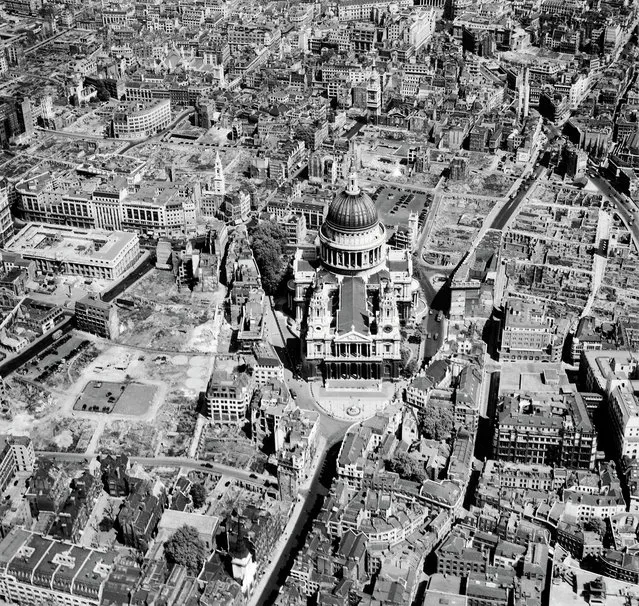
St Pauls Cathedral sits seemingly untouched at the centre of a scene of urban devastation. At the height of the Blitz, Londons largest religious monument was transformed into a symbol of resolve, resilience and hope. Winston Churchill was keenly aware of the role that Christopher Wrens Renaissance masterpiece could play in maintaining national morale and pride, and he issued the order that the cathedral must be preserved at all costs. Patrols monitored the building day and night, with fire fighters on constant standby. Despite mass incendiary bombing raids on central London including an attack on the night of 29 September 1940, which saw the lead in the roof of the Cathedrals dome begin to melt after a direct hit St Pauls remained standing. The media used imagery of the building as potent propaganda, with the famous BBC war correspondent Ernie Pyle going as far as describing it as a picture of some miraculous figure that appears before peace-hungry soldiers on a battlefield. Pyle used the buildings survival to allude rather neatly to a collective spirit of fortitude: St Pauls was surrounded by fire, but it came through. This symbolism remained just as important after the War. In this photograph from 2 June 1947, Aerofilms captured a perfect image of the cathedral as a source of inspiration to begin the rebuilding process both in London, and in Britain as a whole. 1947. (Photo by Aerofilms Collection via “A History of Britain From Above”)
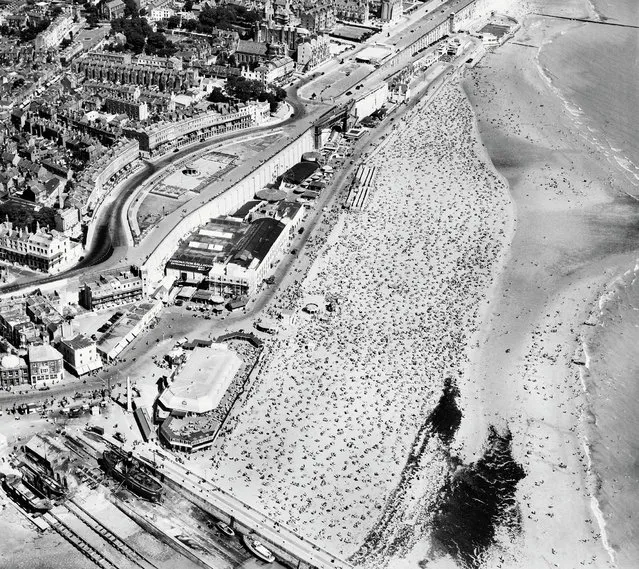
The Times weather forecast for 12 August 1947 advised that a ridge of high pressure had moved in over the British Isles, and that it will be fair and fine or warm. Just like the thousands of holidaymakers shown here spread out across nearly every grain of the Ramsgate Sands, Aerofilms were keen followers of the weather. Clear skies and bright sunlight provided optimal conditions for aerial photography and, particularly in the summer months, almost guaranteed that a flight to the coast would offer up iconic, postcard-friendly shots of the British seaside experience. 1947. (Photo by Aerofilms Collection via “A History of Britain From Above”)
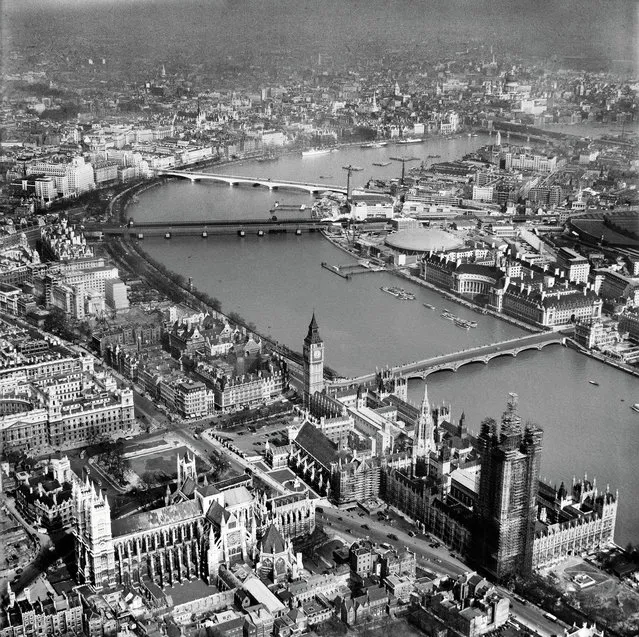
The Houses of Parliament, River Thames and the Festival of Britain South Bank Site, 1951. (Photo by Aerofilms Collection via “A History of Britain From Above”)
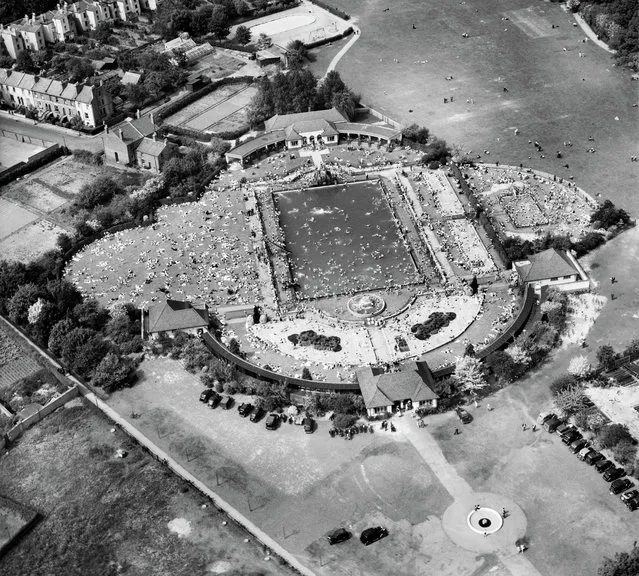
Weekend crowds throng Sandford Park Swimming Pool in Cheltenham in May 1947. First opened in 1935, the Park's massive baths, which measured 165 by 90 feet and held over 498,000 gallons of water, stayed in use throughout the Second World War. Despite a German bomb smashing the paddling pool – seen here on the right of the image – in July 1942, Sandford Park remained extremely popular with the townspeople and visitors, recording some 90,000 admissions each year over the course of the conflict. These attendances may well have been helped by the government's wartime introduction of “double summer time”, which saw the clocks being put forward two hours to allow it to stay light in the south of England until close to midnight. 1947. (Photo by Aerofilms Collection via “A History of Britain From Above”)
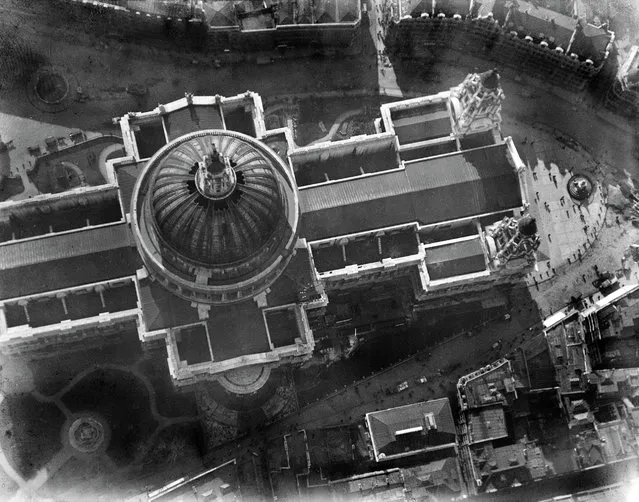
St Paul's Cathedral, London, 1921. (Photo by Aerofilms Collection via “A History of Britain From Above”)
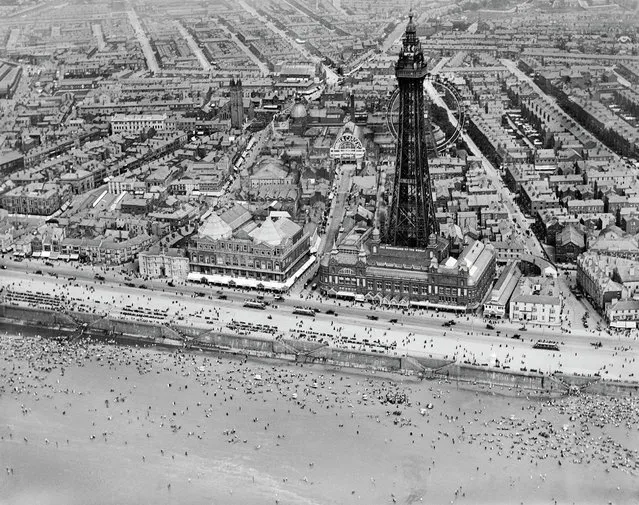
This remarkable shot of Blackpool Tower and the Winter Gardens was a speculative capture by an Aerofilms photographer and pilot as they navigated Englands north-west coastline in July 1920. Both the Blackpool Gazette and the Radio Times bought the image most likely to advertise the town and its increasingly famous attractions to prospective tourists. The Winter Gardens first opened in July 1878 as a six-acre pleasure park made up of concert halls, skating rinks and ballrooms. The year this photograph was taken also marked the first ever staging of the Blackpool Dance Festival in the wonderfully grand Empress Ballroom. Partly hidden in the background here is the Big Wheel, a 220-foot-high ride built by the Winter Gardens as direct competition for the Tower. It remained literally and metaphorically in the shadow of its more celebrated counterpart, and was eventually pulled down in June 1929. 1920. (Photo by Aerofilms Collection via “A History of Britain From Above”)
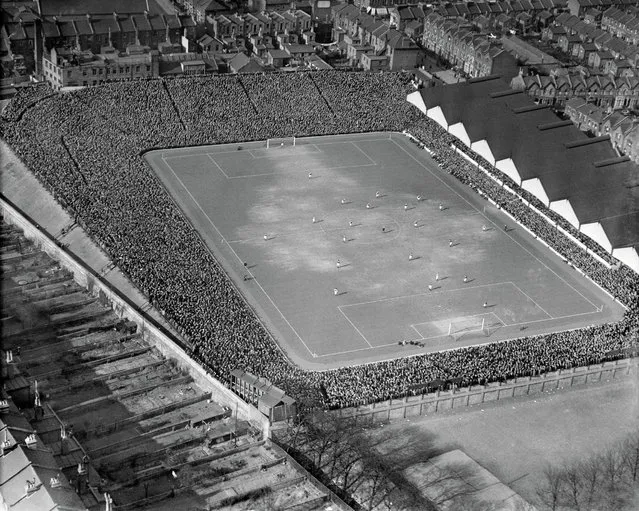
March 23rd 1929, FA Cup Semi Final between Portsmouth And Aston Villa. (Photo by Aerofilms Collection via “A History of Britain From Above”)
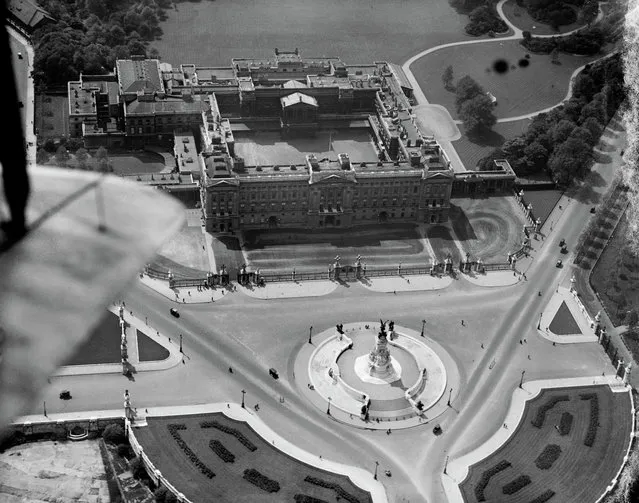
1921 photograph of Buckingham Palace and Queen Victoria memorial. Flight restrictions today would make this a near impossibility. (Photo by Aerofilms Collection via “A History of Britain From Above”)
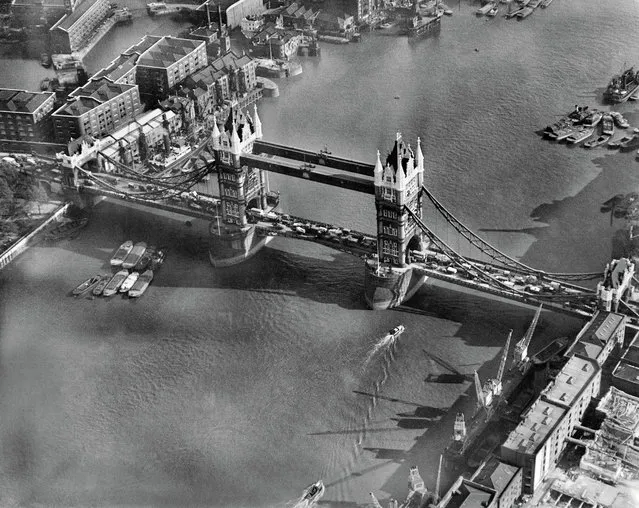
What at first glance stands out as a stunning view of one of London's most recognisable structures becomes more intriguing on closer examination. Here, Tower Bridge is the site of a chaotic logjam of traffic – caused, perhaps, by what seems to be an accident right at the centre of its span. Newspapers at the time reported the closure of the Rotherhithe Tunnel for road works, with Tower Bridge and the Blackwall Tunnel advised as alternative routes. Despite the novelty of horses and carts mixing in the traffic lanes with motorcars, this eight-decade-old image of London congestion may appear wearily familiar to any modern commuter. (Photo by Aerofilms Collection via “A History of Britain From Above”)

A Heinkel He111 bomber flies over central London on 7 September 1940 in this shot taken by the Luftwaffe, and found in a German archive of aerial photography seized by the Allies after the War. Visible directly below is one of the city's key targets – the huge industrial complex of the Royal Docks. 1940. (Photo by US National Archives)
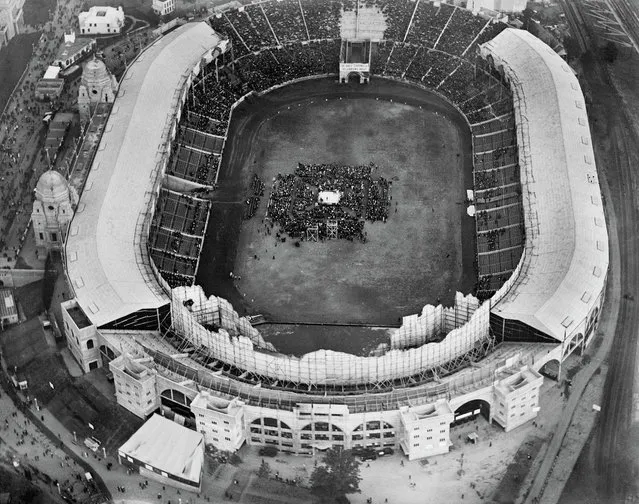
Wembley Park, Boxing Match between Tommy Gibbons and Jack Bloomfield, 1924 Pictured on 9 August 1924, Wembley Stadium is the somewhat unexpected venue for a boxing match between the American heavyweight Tom Gibbons and his British opponent Jack Bloomfield. The stadium was constructed earlier that year as part of the British Empire Exhibition and was described in glowing terms by the official guidebook: There is not in all England a modern building that can compete with the Empire Stadium in the effect it creates upon the mind of the spectator
In a world that has developed so great a devotion to sport there is no arena that can compare with Wembleys. While the bout which was won easily by Gibbons drew a crowd of 50,000, this experiment with boxing in the stadiums wide open spaces was not considered a success. The press reported that the combination of ringside standing room and distant seating failed to create a compelling spectacle or atmosphere, and the fights promoter, Major Arnold Wilson, had to file for bankruptcy immediately afterwards. (Photo by Aerofilms Collection via “A History of Britain From Above”)
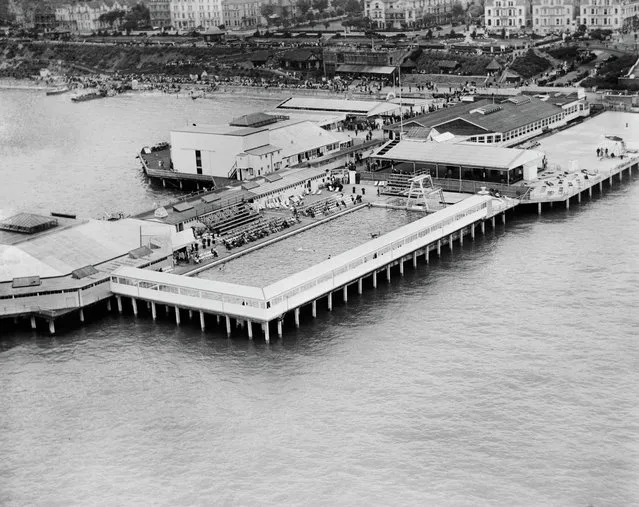
The swimming pool on Clacton Pier, Clacton-on-Sea, 1932. (Photo by Aerofilms Collection via “A History of Britain From Above”)
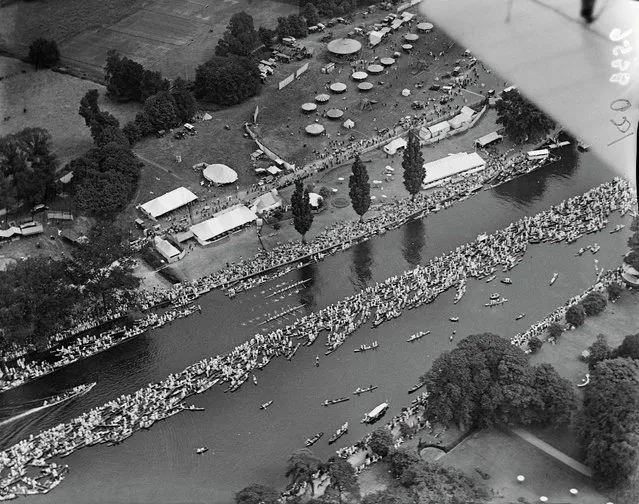
Henley-on-Thames, an Eights race approaches the finish at the Royal Regatta, 1923. Two crews of eights race between the riverbank and a chaotic jumble of spectator boats to approach the finish line of the Royal Regatta at Henley-on-Thames. First held in 1839, the Regatta has been staged annually ever since apart from during the two World Wars. This spectacular image from 7 July 1923 the last day of the Regatta captures the massed crowds of one of the largest attendances that the event had ever seen. A report in The Times two days later remarked that in the afternoon it was not possible to hire a boat of any description. Trains from Paddington had to be run in duplicate, and the motor traffic was much heavier than ever before. 1923. (Photo by Aerofilms Collection via “A History of Britain From Above”)
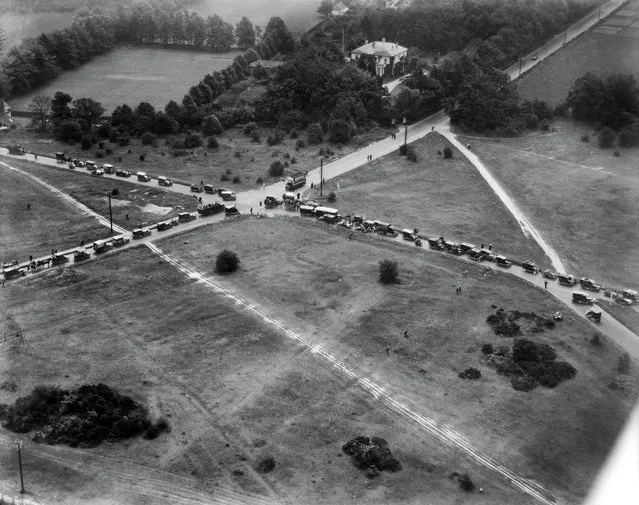
Traffic Jam, on the way to Epsom Derby 1923. In this photograph of a three-way traffic jam at Fir Tree Road in Banstead in Surrey, taken on the day of the 1923 Epsom Derby, it is easy to see why Alan Cobham saw aviation as the only solution to Britains road congestion business. In his autobiography A Time to Fly, Cobham recalled how Francis Wills came up with the idea of flying over Epsom to survey and photograph the worst of the Derby Day jams to help the police plan anti-congestion measures in the future. They even invited a senior officer to go up in an Aerofilms aircraft to direct operations on the ground by radio. As Cobham recalled, this was a qualified success. Unused to aviation, the officer was so horribly sick that he was able to do practically nothing. So the pilot and photographer took over the job, passing messages down to the police on the ground about the traffic situation as it developed, and taking pictures of it at the same time: and the joke is that when they landed the suffering officer was summoned to receive the Kings congratulations
Nobody revealed his secret. 1923. (Photo by Aerofilms Collection via “A History of Britain From Above”)
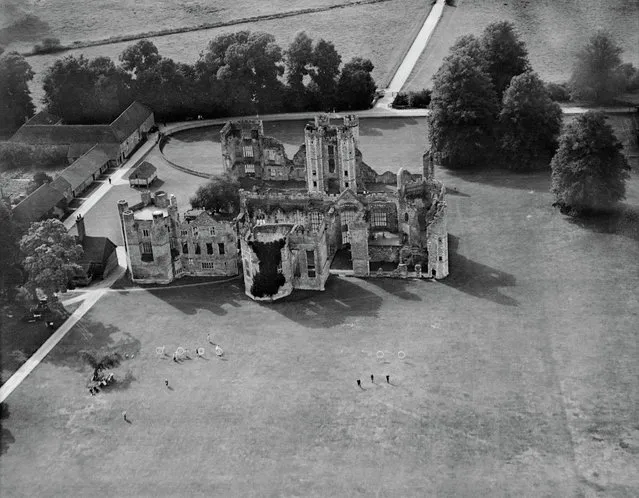
Archery at Cowdray House, Easebourne, 1928. (Photo by Aerofilms Collection via “A History of Britain From Above”)
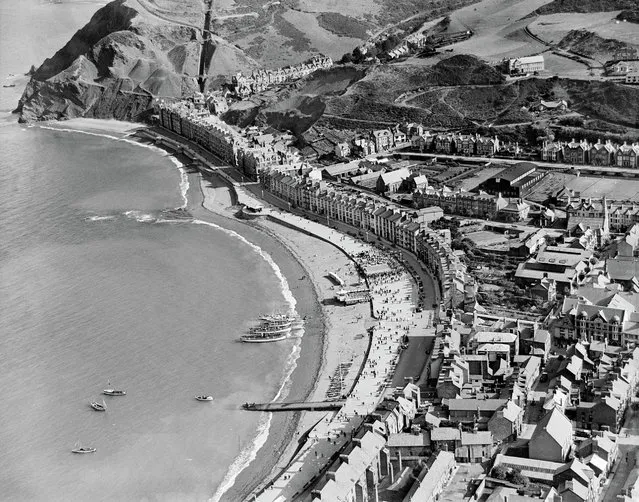
General view of Aberystwyth showing seafront and town in summer, The dignified seafront of Aberystwyth is captured here in the summer of 1932, with pleasure boats moored on the beach ready to take holidaymakers on trips around Cardigan Bay. This mid-Wales market town enjoyed a sustained tourist boom following the arrival of the railways in the latter half of the nineteenth century which also coincided with the evolution of the religious ceremony of wakes week into a regular summer holiday for industrial workers from the West Midlands. As the nearest seaside resort to the Midlands, Aberystwyth quickly became a popular destination, and was even billed as the Biarritz of Wales. The Great Western Railway Company promoted the town intensively during the 1930s through a series of eyecatching graphic posters. When Aerofilms toured west Wales in 1932, Aberystwyth was an obvious target for aerial photography to sell on for potential publicity and marketing purposes. 1932. (Photo by Aerofilms Collection via “A History of Britain From Above”)

Piccadilly Circus, Westminster. Pictured here in March 1921 – before the installation of any traffic lights – Piccadilly Circus is a busy throng of pedestrians, horsedrawn carriages, omnibuses and motorcars, all revolving around the aluminium-cast statue of Eros. Even at this fledgling stage in Aerofilms' existence, the company was targeting wellknown sites and landmarks to sell to postcard manufacturers. Early clients for this kind of material included “Ludo Press” – a company that is still in business today – and “LepAerial Travel Bureau”, one of the first ever travel agencies to arrange assenger transport on aircraft. That LepAerial also had an office in Piccadilly Circus was unlikely to be a coincidence. 1921. (Photo by Aerofilms Collection via “A History of Britain From Above”)
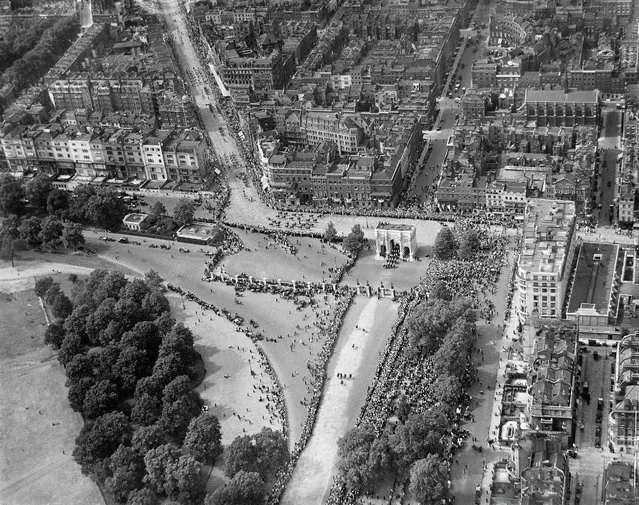
Crowds line the streets of Edgware Road, Hyde Park Corner and Park Lane for the homecoming procession of Edward Prince of Wales – the future King Edward VIII. 21 June 1922 marked the Prince’s return to London from his “Oriental Grand Tour”, an eight-month sojourn to India, Ceylon, the Philippines, Borneo, Malaysia, Japan and Egypt. The tour was conducted as part of Edward’s role as Britain’s “Empire Ambassador” – although it has subsequently emerged that neither the Prince nor his various hosts were enthusiastic supporters of the trip. The writer E. M. Forster even noted quite bluntly that “scarcely anyone in India wished the Prince of Wales to come” – a sign perhaps of the increasing fragility of the Empire in the aftermath of the First World War. The Prince arrived back in Plymouth on HMS Renown and, after a train journey to Paddington Station, embarked on this elaborate ceremonial procession all the way to the gates of Buckingham Palace. 1922. (Photo by Aerofilms Collection via “A History of Britain From Above”)
25 Feb 2014 12:59:00,
post received
0 comments
